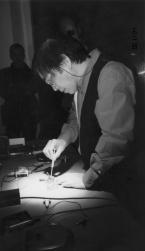"Natural Radia"
Eine Live-Performance
von Tetsuo Kogawa
im Rahmen von phonoTAKTIK.02

Ein Wiencouver Projekt / A Wiencouver Project
documentation of the live event
Sound technician/ Technik: Gerald Ernst & Gerhard Wieser
Webteam: August Black & Martin Breindl

PLAY
A CASSETTE OF THIS PROGRAM CAN BE ORDERED FROM THE "ORF TONBANDDIENST"
|
The Mini-FM Performance "Natural Radio" by Tetsuo Kogawa The japanese artist and communication theorist Tetsuo Kogawa pays attention to a more micro area of radio as an alternative to mass media and global communications, thus theoretically connecting with the creative potential and visions of early radio, that have long been erased in the history of the medium. The possibilities of media such as sattelite communications or the internet have changed the popular communication concepts and have opened up the possibility for radio of concentrating on the local territory. Since the early 80s Kogawa built simple "Mini-FM" transmitters with cheap materials and spread building instructions of these radios with very little power judged by any standard-usually less than a hundred milliwatts and could cover a half-mile radius. "Although such a weak signal may seem to be of no use for broadcasting, the purpose was not broadcasting but narrowcasting" (Kogawa). As a result in Japan a "Mini FM" boom began in the early 80s: a radio with literally micro-powered transmitter, transmitting with a limited area of transmission signal. Everyone can build his own radio transmitter and use it for his own purposes - alternative information for a mini-audience becomes possible and the relation between those who speak and those who listen changes fundamentally. A tool, that creates a structure "beyond electronic individualism". "The action of transmitting together changed the relationships because we were narrowcasting rather than broadcasting." In his performance "Natural Radia" Kogawa takes FM transmitters with microphone, puts them at different places around the space and tunes the radio receivers to the frequencies of transmitters. Each receiver will be set at different places in the process of the performance. Arranging, tuning and mixing process will be shown in the studio space. "Given the difference of transmitting and receiving capabilities of the receivers and transmitters and also the distances between them, the space has a variety of sounds: direct, looped, howling and unexpected. All process of making, setting, tuning and mixing (without using any ready-made mixer at all) is the performance work" (Kogawa). The phenemonology of transmission will take place in one single, multilayered communicationspace. In the foreground stands, just as the futurist Filippo Tommaso Marinetti and Pino Masnata demanded in their manifesto "La Radia", the transmission of - in this case "natural" sounds from the space - data itself. Communication is brought back to the immediate surrounding. |
|
Die Mini-FM Performance "Natural Radio" von Tetsuo Kogawa Der japanische Künstler und Kommunikations-Theoretiker Tetsuo Kogawa arbeitet mit einer betont lokalen Verwendung des Mediums Radio und lehnt sich gedanklich insgesamt an die Frühform des Radios an: er will das kreative Potential und Visionen zurückgewinnen, die in der Geschichte des Mediums und seiner Massenverwendung längst ausgeblendet wurden. Das Radio muss sich "erholen" - und kann es auch. Denn die Möglichkeiten globaler Kommunkation durch Medien wie das Internet haben die populären Kommunkationskonzepte verändert und dem Radio auch die Möglichkeit des Rückzugs ins Kleine und Lokale eröffnet. Warum also nicht nur mit dem Sendebereich für einen einzigen Häuserblock arbeiten? Kogawa hat seit den 80er Jahren aus billigen Materialien einfache "Mini-FM"-Sender hergestellt, um die einseitige Struktur der monopolisierten Massenmedien zu unterlaufen und löste damit einen wahren Boom aus. Eine Gesetzeslücke in Japan ausnutzend, die schwachen Sendern auch eine private Nutzung des FM-Raumes erlaubt, verbreitet Kogawa Anleitungen zum Bau dieser "Mikro-Radios" mit einer Reichweite von bis zu 1 km. Ein jeder kann sich somit einen Sender basteln und für eigene Interessen verwenden. Ein Prinzip das, so der Künstler, nicht nur eine Vielzahl von unterschiedlichsten Sendern für alternative Informationen für eine Kleinstöffentlichkeit ermöglicht, sondern auch das Verhältnis derer die Sprechen und derer die Zuhören grundlegend verändert. Ein Werkzeug also, das eine Struktur "jenseits elektronischen Individualismus" schafft. Was geschieht nun, wenn sich Senden und Empfangen innerhalb nur eines einzigen Raumes abspielt? In der Performance "Natural Radia" wird sich die Phänomenologie der Übertragung in einem vielschichtigen Kommunikationsraum aus Mini-FM-Sendern und Empfängern noch verdichten. Die lokale Kommunikationserfahrung im Studioraum wird simultan geöffnet durch ein Telephoninterview mit dem kanadischen Medienkünstler Hank Bull über das Konzept von Mikro-Radio und Kommunikationsmöglichkeiten. Im Vordergrund steht, ganz im Sinne des Manifestes "La Radia" der Futuristen Filippo Tommaso Marinetti und Pino Masnata (das auch einen massgeblichen Referenzpunkt der Kunstradio-Projekte "Geometrie des Schweigens", "Sound Drifting" oder "Radiation" bildete), das Senden von - in diesem Fall natürlichen Geräuschen - selbst. Kogawa führt die Kommunikation sinnbildlich auf den nächsten Umraum zurück - und Elektronik auf die Funktion, Kommunikation und reale Nachbarschaften wiederzufinden. |
[TOP]